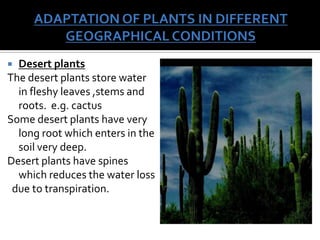Animal and plant adaptation
- 2. An adaptation is a change in an organism that help it survive and reproduce in its environment. OR It may be also defined as.. The adjustment or changes in behavior ,structure and physiology of an organism to become more Suited to environment.
- 3. Desert plants The desert plants store water in fleshy leaves ,stems and roots. e.g. cactus Some desert plants have very long root which enters in the soil very deep. Desert plants have spines which reduces the water loss due to transpiration. ÔÇ°
- 4. Leaves are small and tough so not likely to be damaged by snow or hail. ÔÇ° They have tough covered seeds that can survive cold . ÔÇ° Roots grow deep so it can cope with the strong winds. ÔÇ° Trees grow triangular in shape so snow can fall from it . ÔÇ°
- 5. Plants in plains are generally adapted to both dry and extreme temperature. ÔÇ° Grasses dominate the landscape. ÔÇ° Short and strong roots are present. ÔÇ° Shrubs are present in the plains. ÔÇ°
- 6. In oceans planktons are plants floats ,they are able to do photosynthesis. ÔÇ° Plants which floats on surface have developed air pockets in there leaves. ÔÇ°
- 7. These animals live in burrows to avoid the sun. e.g. kangaroos. ÔÇ° Animals intake water from other sources like there food also. ÔÇ° Scorpions have outer hard skin to reduce water loss. ÔÇ° Camels store fat in hump and water in long neck ,and also have cushioned foot . ÔÇ°
- 8. These animals have developed fur for the purpose of insulation. ÔÇ° These animals have thick layer of fat on them which give them heat. ÔÇ° Bears undergo hibernation during winter season. ÔÇ° Increased lung capacity. ÔÇ°
- 9. Migrations for the food and water. ÔÇ° Living in burrows to save them from predators. ÔÇ° Living in herds. ÔÇ° They use camouflage to blend in with their surroundings and have grass-colored tan fur. ÔÇ°
- 10. Some animals use camouflage to escape and avoid detection. ÔÇ° Some animals have coloration which intentionally makes them hidden. ÔÇ° Some animals have dangerous spines or venom for protection. ÔÇ° Fishes have gills for breathing. ÔÇ°










